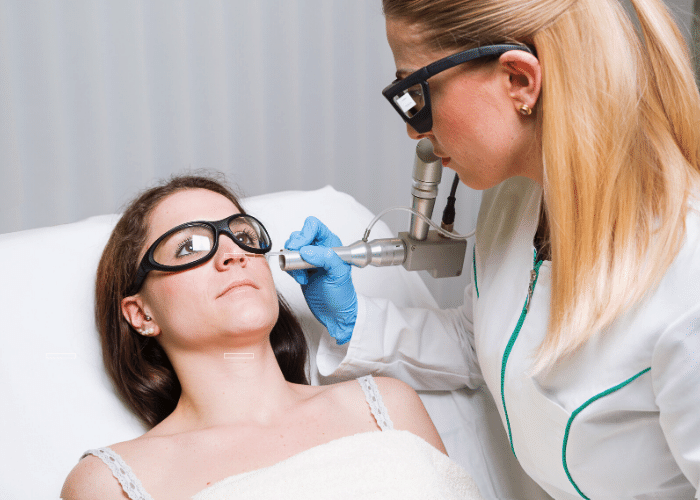Just because warts happen to most of us doesn’t mean they’re a welcome sight on our skin. But fortunately, we’re not powerless to get rid of warts and claim clear skin once again, according to Judy Hu, MD, of Advanced Dermatology P.C. Almost everyone gets a wart at some point in their lives, according to the National Institutes of Health.
But few realize that these harmless skin growths are usually caused by a common virus called human papillomavirus (HPV), which typically enters the skin through a cut or nick. Once there, the virus prompts the top layer of skin to grow rapidly, forming a wart – usually on the hands or feet, but warts can appear almost anywhere on the skin.
“The bad news is that warts are easily spread – you can re-infect yourself by touching the wart and then touching another body part, and you can infect another person by sharing razors, towels or other items that touch the skin,” explains Dr. Hu, a dermatologist specializing in both medical and cosmetic dermatology. “But you won’t realize right away that you’ve spread the wart, since it usually takes several months of slow HPV growth under the skin before you notice a new wart.”
Different kinds of warts
Some people are more susceptible to HPV – and therefore, to developing warts – than others, Dr. Hu notes. How do you know if your skin bump is a wart? It can have a rough or smooth surface, depending the type. Here, Dr. Hu describes 4 types of skin warts:
- Common warts: Usually found on the fingers and back of the hands, common warts may have tiny black dots in them that are actually minute blood vessels feeding the wart. “Usually, common warts look and feel like rough little bumps,” Dr. Hu says.
- Plantar warts: Found on the soles of the feet, these tough-to-treat warts can grow in clusters, resembling a bumpy, spread-out landscape. They can also hurt, since walking places pressure on plantar warts, Dr. Hu says.
- Flat warts: Often occurring in children on the face, flat warts are smaller and smoother than other warts and tend to grow in large numbers from 20 to 100 at a time, Dr. Hu explains.
- Filiform warts: Resembling thin “fingers” or long threads that stick out, filiform warts often grow around the eyes, mouth and nose and tend to grow quickly, Dr. Hu says.
“No matter the type of wart, eventually they’ll usually go away on their own without treatment,” she says. “But if your warts hurt, bleed or itch; quickly multiply; or cause embarrassment, you’ll want to take action.”
Tips on treatment options for warts
The good news is there are several at-home wart treatments available, as well as a wide variety of additional treatments a dermatologist can utilize to get rid of stubborn or painful warts. At-home wart treatments include:
- Salicylic acid: This over-the-counter medication comes in gel or liquid forms or infused into pads and slowly erodes warts. It may take many weeks to see results, and it helps if you soak the wart in warm water before applying salicylic acid, Dr. Hu says.
- Duct tape: This old folk remedy rarely works, but covering warts with duct tape in conjunction with salicylic acid can sometimes peel away the wart’s layers, Dr. Hu says.
Dermatologist treatments include:
- Cantharidin: A chemical compound secreted from beetles, Cantharidin is “painted” over a wart, prompting a blister to form under it. The dead wart will then peel off on its own a week or so later.
- Cryotherapy: This treatment freezes warts and typically requires several applications.
- Electrosurgery and curettage: This treatment burns warts away, and curettage involves scraping away the wart afterward with a sharp instrument.
- Excision: This treatment cuts warts out of the skin.
- Lasers: For warts that haven’t responded to other treatments, lasers can eradicate them.
- Chemical peels: Flat warts, which are often widespread, are best targeted by chemical peels applied over many sessions.
- Bleomycin: This chemical is sometimes injected into warts.
- Immunotherapy: Sometimes used on treatment-resistant warts, immunotherapy prompts the patient’s own immune system to fight the warts.
“Of course, the best treatment for warts is preventing them in the first place,” Dr. Hu says. “While we can’t always prevent a wart from forming, we can try. Don’t touch yours or others’ warts without washing your hands afterward, and make sure you wear flip-flops or pool shoes in public showers and locker rooms. Also, don’t share towels, razors or other personal items that touch people’s skin. A little vigilance can help keep warts at bay.”
Judy Hu, M.D., F.A.A.D., a board certified dermatologist and fellow of the American Academy of Dermatology, specializes in medical, surgical, and cosmetic dermatology with extensive experience in skin rejuvenation utilizing injections and laser therapy.
Advanced Dermatology P.C. and the Center for Laser and Cosmetic Surgery (New York & New Jersey) is one of the leading dermatology centers in the nation with 18 locations in New York and New Jersey, offering highly experienced physicians in the fields of cosmetic and laser dermatology as well as plastic surgery and state-of-the-art medical technologies.www.advanceddermatologypc.com.
The Editorial Team at Lake Oconee Health is made up of skilled health and wellness writers and experts, led by Daniel Casciato who has over 25 years of experience in healthcare writing. Since 1998, we have produced compelling and informative content for numerous publications, establishing ourselves as a trusted resource for health and wellness information. We aim to provide our readers with valuable insights and guidance to help them lead healthier and happier lives.
































